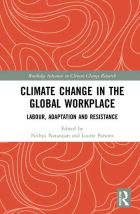Climate Change in the Global Workplace: Labour, Adaptation and Resistance

Climate Change in the Global Workplace calls for joint attention to labour precarity and environmental precarity – specifically recognizing how capitalism, colonialism and inequality have contributed to both types of vulnerability. “As we argue, it is not climate change in a direct sense but rather climate change understood to result from broader processes of capitalist growth which have concomitantly entrenched hundreds of millions of workers in insecure work.” The chapters are grouped into three sections: labour, adaptation and resistance.
The chapter on heat in the Cambodian brick industry elaborates a “thermal inequality” framework, in which “physically embodied thermal inequalities are transported between places by social and economic linkages which cross-cut local environmental conditions. Simply put, those who experience heat stress in one place are more likely to experience it in another.”
One type of inequality here is geographical: heat stress is higher in low-income countries, and also unevenly distributed within a country, which can drive workers into different regions and sectors of work. Formality also cushions responses to heat; informal workers are generally more exposed to extreme heat and have fewer material resources to respond to it.
Some Cambodians leave agricultural livelihoods, which are being devastated by erratic rainfall, to enter largely debt-bonded positions in brick kilns. There they work under extremely hot conditions – “from transporting bricks under the midday sun to hours spent stoking kilns which can reach up to 1,100 degrees Celsius”, which induces headaches and dizziness – even without the exacerbating effects of planetary heating. Thus, climate change shadows low-income workers, whether they’re farming or producing bricks. The case study provides further evidence that climate migration, as a strategy to reach economic security, is not available to everyone.
Laurie Parsons, the author of this chapter, also documents the cyclical nature of heat vulnerability for entire families and communities. Remittances from brick workers are lower than from other types of employees, leading to a lower ability to deal with heat stress among the families of these workers.
Another chapter explores the dilemma facing Indigenous communities in Canada’s Arctic and sub-Arctic regions: the oil and gas industry is providing much-needed jobs, yet intensifying the rate of climate collapse. On the other hand, climate change is threatening Arctic ecosystems, food systems and ways of life. The resolution of this dilemma is a matter of survival.
The tension is both urgent and rooted in a longer history. As Métis author Kimberleigh Schultz writes, “this is rooted in a context where broader structural processes of Settler Colonialism have eroded the choices for autonomy and livelihood for many Indigenous communities, leaving participation in extractive industries as one of the few remaining forms of adaptation available…This analysis pushes us to rethink linear narratives of adaptation, and to instead situate them within a wider context of what constitutes adaptation and resistance in constrained circumstances.”
As the authors and editors of this book argue, current perspectives on climate adaptation are insufficient to grapple with the scale of climate-related disruptions and their interlinkages with unstable work – particularly among the brickmakers, miners, farmers, and many other people who continue to fashion their own forms of resistance.
Further reading:
Bahadur, Aditya and Thomas Tanner (2014), “Transformational resilience thinking: putting people, power and politics at the heart of urban climate resilience”, Environment and Urbanization Vol 26, No 1, pages 200–214, available at https://journals.sagepub.com/doi/full/10.1177/0956247814522154.
Kjellstrom, Tord, Nicolas Maître, Catherine Saget, Matthias Otto and Tahmina Karimova (2019), Working on a Warmer Planet: The Effect of Heat Stress on Productivity and Decent Work, International Labour Organization, available at https://www.ilo.org/global/publications/books/WCMS_711919/lang--en/index.htm.
Weitner, Viviane (2006), Lutsel K’e Dene First Nation’s Experience Negotiating with Mining Companies, The North-South Institute, available at http://www.nsi-ins.ca/publications/first-nations-mining-companies/.
Book note prepared by Christine Ro
Search the Book notes database
Our Book notes database contains details and summaries of all the publications included in Book notes since 1993 - with details on how to obtain/download.
Use the search form above, or visit the Book notes landing page for more options and latest content.
For a searchable database for papers in Environment and Urbanization, go to http://eau.sagepub.com/

